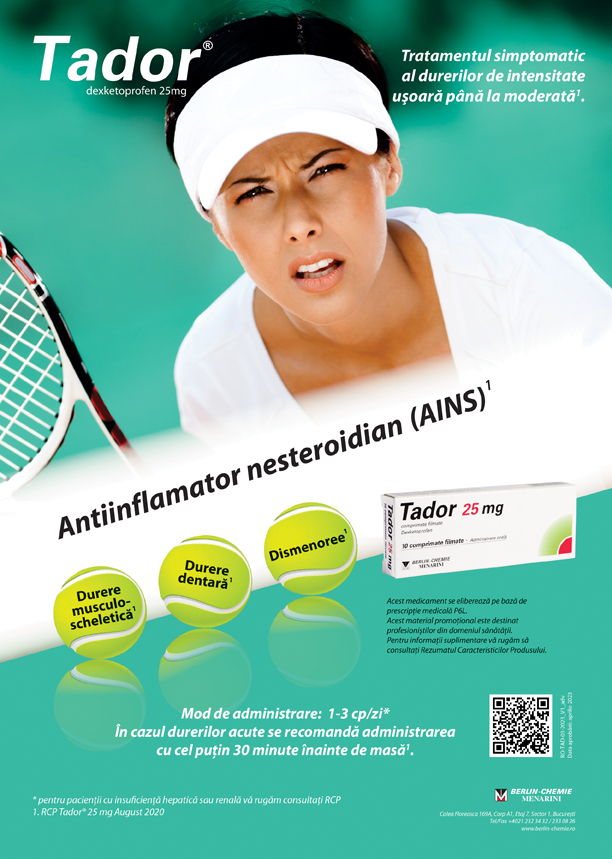Authors: Marius-Nicolae Popescu1,2, Luminiţa Dumitru1,2, Matei Teodorescu1,2, Alina Iliescu1,2, Mihai Berteanu1,2
Affiliation
1“Carol Davila” University of Medicine and Pharmacy Bucharest, Romania
2Medical Rehabilitation Department of the Elias Emergency University Hospital, Bucharest, Romania
Abstract
Background. TXB-A injections are the first-line treatment of many movement disorders, and the safety of doing them is essential to the effectiveness of therapy.
Aims. Evaluation of safety of TXB-A guided injections in upper limb spasticity of post-stroke patients.
Methods. The groups studied were composed of 60 patients, which were divided based on the doses provided in each
muscle of the hand and wrist exors (250 IU versus 333 IU). Every patient received a total dose of 1000 IU of TxB-A. The pa-
rameters that were assessed were: Modied Ashworth Scale (MAS) and Activities of Daily Living Scale (ADL), international
scales for spasticity and functionality. The moments evaluated were: T0 (the initial time – injection time), T1 (one month after
the injection) and T2 (3 months from T0 or 2 months from T1).
Methods. The groups studied were composed of 60 patients, which were divided based on the doses provided in each
muscle of the hand and wrist exors (250 IU versus 333 IU). Every patient received a total dose of 1000 IU of TxB-A. The pa-
rameters that were assessed were: Modied Ashworth Scale (MAS) and Activities of Daily Living Scale (ADL), international
scales for spasticity and functionality. The moments evaluated were: T0 (the initial time – injection time), T1 (one month after
the injection) and T2 (3 months from T0 or 2 months from T1).
Methods. The groups studied were composed of 60 patients, which were divided based on the doses provided in each
muscle of the hand and wrist exors (250 IU versus 333 IU). Every patient received a total dose of 1000 IU of TxB-A. The pa-
rameters that were assessed were: Modied Ashworth Scale (MAS) and Activities of Daily Living Scale (ADL), international
scales for spasticity and functionality. The moments evaluated were: T0 (the initial time – injection time), T1 (one month after
the injection) and T2 (3 months from T0 or 2 months from T1
Methods. The groups studied were composed of 60 patients, which were divided based on the doses provided in each
muscle of the hand and wrist exors (250 IU versus 333 IU). Every patient received a total dose of 1000 IU of TxB-A. The pa-
rameters that were assessed were: Modied Ashworth Scale (MAS) and Activities of Daily Living Scale (ADL), international
scales for spasticity and functionality. The moments evaluated were: T0 (the initial time – injection time), T1 (one month after
the injection) and T2 (3 months from T0 or 2 months from T1
Methods. The study group comprised 60 patients distributed in 3 subgroups of 20 based on background medication administered in post-stroke management: 20 patients in the antiplatelet background subgroup, 20 patients in the subgroup of anticoagulant background medication, and 20 without anticoagulant/antiplatelet background medication. From the 60 patient group, based on the number of TXB-A injection cycles, 3 other subgroups were produced: 20 patients performed 3 injection cycles, 20 performed 2 cycles, and 20 completed a single injection cycle.
Every patient received a total dose of 1000 UI of TXB-A. After each set of local injections, ultrasounds were performed at the injection site searching for local hematomas. The moments evaluated were: T0 (the initial time – injection time), T1 (one month after the injection), T2 (3 months from T0 or 2 months from T1), T3 (1 month after T2), T4 (3 months after T2 or 2 months after T3) and T5 (1 month after T4).
Results. The lowest p value of the 3 possible comparisons of the anticoagulant, antiplatelet, no anticoagulant/antiplatelet group of patients was 0.856, showing a purely random distribution of adverse effects manifested by local hematomas following ultrasound guided injections
Conclusions. Multiple cycles of US guided TXB-A injections with a minimum 3-month frequency between injections do not increase the risk of local haematomas.
Key words: botulinum toxin type A, ultrasound guided injections, safe treatment
07%20-%20popescu%20%20%20%2066-69










